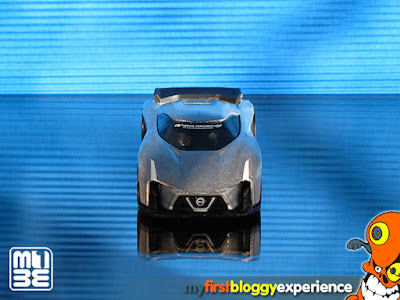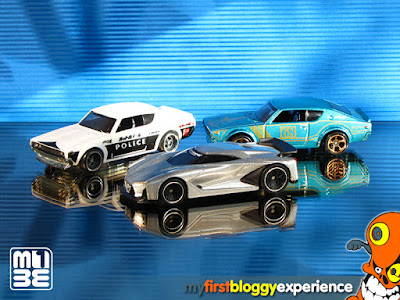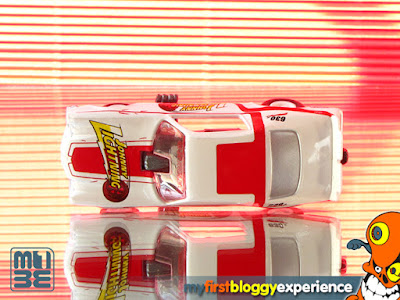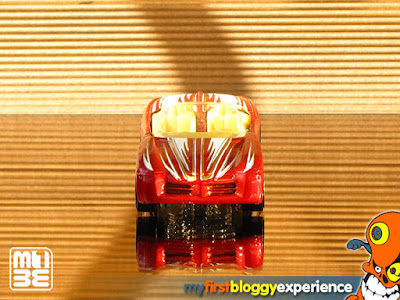For English version scroll below
Autos conceptuales desarrollados para videojuegos, que de alguna manera se las arreglan para llegar a ser prototipos reales, mostrando elementos de diseño que serán incluidos en vehículos de producción, en el corto o mediano plazo, sonarían como una idea inverosímil hace apenas 25 años...
Pero esa clase de cosas ya no son inverosímiles, considerando la situación de un escenario mundial donde los medios virtuales o digitales en términos generales se están convirtiendo en una influencia cada vez más poderosa, prevalente y eso está lejos de ser una mera coincidencia, si me lo preguntas...
Aún menos considerando que todos los segmentos de la industria pertenecen a unas pocas familias alrededor del mundo, que son dueñas también del sistema bancario, los medios, el comercio y así es como las tendencias son fácilmente impuestas sobre la población a nivel mundial: con semejante nivel de control, las coincidencias simplemente no tienen lugar...
Mi invitado para esta publicación es un ejemplo claro de la tendencia ya mencionada al principio, una idea propuesta a diferentes marcas renombradas, no solo de la industria automotriz, por el equipo de Polyphony Digital Inc., creadores de la franquicia Gran Turismo para la plataforma PlayStation.
Solo para 2014, once marcas de coches se unieron a la alineación: Mercedes-Benz, BMW, Mitsubishi, Volkswagen, Toyota, Aston Martin, Chevrolet, Subaru, Mazda, Infiniti y obviamente, Nissan; casi cada año, desde entonces, más marcas se están uniendo, cada una aportando su propio carro virtual a esta idea del proyecto Vision.
Varios de estos conceptos permanecen solo como eso, conceptos, pero ese no es el caso con el Nissan Vision 2020 Gran Turismo de 2014, un Auto Conceptual Coupé Compacto 2 Puertas Fastback / Auto Super Deportivo / Super Auto / Gran Turismo.
Un prototipo (no funcional) fue introducido en el Festival de la Velocidad Goodwood de 2014, un evento que tuvo lugar en lo más profundo de Sussex Occidental, Reino Unido, junto con otro prototipo del Aston Martin DP-100 Vision Gran Turismo Conceptual y un grupo de vehículos mucho más con los pies sobre la tierra, de diferentes marcas.
El Nissan Vision 2020 Gran Turismo de 2014, fuertemente basado en el Nissan GT-R, producido desde 2007, fue desarrollado con la colaboración de Nissan Design Europe y Nissan Technical Centre: el resultado muestra un enfoque retrofuturista, con un sabor raro de auto conceptual de los 90s, que de alguna manera luce actual, con una silueta atractiva, pero algo pesada, que mantiene la esencia del GT-R...
Estoy retornando para la reseña presentada hoy, a una Línea de productos desarrollados por Hot Wheels desde 2013, introducida como Retro Entertainment, de la cual he estado publicando algunos vehículos en sus numerosos surtidos o mixes, como aquí, aquí, aquí, aquí y aquí...
Esta Línea incluye varias Series representando diferentes franquicias y tengo que decir que puedes encontrar una selección muy interesante de "celebridades" automotrices, así como otro tipo de vehículos y medios de transporte icónicos, pero la ejecución general es apenas decorosa en la mayoría de casos, con unos pocos altos y un montón de bajos: exactamente lo que deberías esperar de esta marca, como coleccionista experto.
Conseguí este artículo a través del mercado secundario, con la ayuda de un amigo mío, colega coleccionista e importador / vendedor privado, hace más o menos 9 años, por la época en que fue lanzado originalmente y fue relativamente fácil de encontrar en ese momento.
A pesar de la popularidad del videojuego, la versión auto de juguete de este coche conceptual no ha sido un gran favorito, pero para mí, eso es mucho mejor ya que: uno, trato de evitar las cosas "populares" y dos, me gusta realmente la propuesta de diseño hecha con este carro.
El producto fue desarrollado por Mark Jones, un diseñador con el cual estoy familiarizado y admiro su trabajo, la prueba de esto es, bueno, tengo varios artículos diseñados en su forma de coches de juguete por él; curiosamente, este modelo ha tenido solo 2 iteraciones, un artículo muy subutilizado, para Líneas en la categoría Adulta (muy engañosamente etiquetadas como "Premium") y ambas iteraciones son prácticamente idénticas.
Mi invitado pertenece a la Serie Hot Wheels Entertainment / Gran Turismo de 2016 y la otra versión fue hecha para la Línea paralela Pop Culture de 2024 / Serie Gran Turismo 7.
Ofrece construcción completa en diecast (carrocería y chasis), el nivel de detalle es bueno, pero las curvas complejas del carro real fueron pobremente presentadas en el molde, especialmente en la parte superior de los guardafangos; algunas veces, como esta vez, insertos plásticos o la sinergia de las partes / moldes plásticos, con los moldes en diecast pueden ofrecer una mejor presentación del producto.
Lo que quiero decir es que el guardafangos trasero de dos partes del auto real, debía ser representado apropiadamente con un inserto plástico o modificando el molde de los interiores para incluir este "spoiler de guardafangos" negro / gris bronce, así como el alerón trasero, pero Hot Wheels decidió ir con su típica política de recorte de costos y ese aspecto castiga el producto claramente (Hot Wheels siendo Hot Wheels, ya sabes).
El trabajo de pintura fue hecho en plateado con acabado Metalflake, muy similar al usado en uno de los prototipos no funcionales, el spoiler del guardafangos trasero y el alerón trasero recibieron pintura negra con acabado satinado, que fue rociada, en lugar de tampografiada y el acabado deja que desear; el chasis recibió pintura negra satinada y ese es un toque agradable.
Fue complementado por una decoración minimalista, para las luces delanteras y de cola, así como una cenefa sobre el parabrisas, con tampos y/o calcomanías, en negro, blanco y rojo oscuro; el enfoque usado aquí funciona bien en esta clase de modelo.
Los interiores fueron trabajados en negro, con un nivel de detalle muy básico; las ventanas son ahumadas; las ruedas multiparte Real Riders presentan diseño de rimes Modern Concave, que no es siquiera similar al usado en el auto real, pero luce bonito, en acabado negro con labio cromado, llantas lisas en caucho sintético, más grandes atrás, a diferencia del coche real y fue hecho en Malasia...
Hch 24:1-8 "Y cinco días después descendió el sumo sacerdote Ananías, con algunos de los ancianos, y un cierto Tértulo, orador; y parecieron delante del gobernador contra Pablo. Y citado que fué, Tértulo comenzó a acusar, diciendo: Como por causa tuya vivamos en grande paz, y muchas cosas sean bien gobernadas en el pueblo por tu prudencia, siempre y en todo lugar lo recibimos con todo hacimiento de gracias, oh excelentísimo Félix. Empero por no molestarte más largamente, ruégote que nos oigas brevemente conforme a tu equidad. Porque hemos hallado que este hombre es pestilencial, y levantador de sediciones entre todos los Judíos por todo el mundo, y príncipe de la secta de los Nazarenos: El cual también tentó a violar el templo; y prendiéndole, le quisimos juzgar conforme a nuestra ley: Más interviniendo el tribuno Lisias, con grande violencia le quitó de nuestras manos, mandando a sus acusadores que viniesen a ti; del cual tú mismo juzgando, podrás entender todas estas cosas de que le acusamos."
English version
Concept cars developed for videogames, that somehow manage to become actual prototypes, displaying elements of design that will be included in production vehicles, in the short or middle term, would sound like a rather farfetched idea barely 25 years ago...
But that kind of things are no longer farfetched, considering the situation of a world scenario where the virtual or digital media in general terms are becoming an influence increasingly powerful, prevalent and that’s far from being a mere coincidence, if you ask me...
Even less considering that the whole industry segments belong to a few families around the world, as well as the banking system, the media, the commerce and that’s how trends are easily pushed on the population worldwide: with such a level of control, coincidences simply have no place...
My guest for this publication is a clear example of the trend already mentioned in the beginning, an idea proposed to different renowned brands, not only from the car industry, by the team of Polyphony Digital Inc., creators of the Gran Turismo franchise for the PlayStation platform.
Only for 2014, eleven car brands joined the line-up: Mercedes-Benz, BMW, Mitsubishi, Volkswagen, Toyota, Aston Martin, Chevrolet, Subaru, Mazda, Infiniti and obviously, Nissan; almost every year, ever since, more brands are joining, each one contributing their own virtual car to this project Vision idea.
Several of these concepts remain as just that, concepts, but that’s not the case with the 2014 Nissan Vision 2020 Gran Turismo, a Compact 2-Door Fastback Coupe Concept Car / Super Sports Car / Super Car / Grand Tourer.
A (non-functional) prototype was introduced at the 2014 Goodwood Festival of Speed, an event that took place in the deepest West Sussex, United Kingdom, along with another prototype of the Aston Martin DP-100 Vision Gran Turismo Concept and a bunch of way more down to earth vehicles, from different brands.
The 2014 Nissan Vision 2020 Gran Turismo, heavily based on the Nissan GT-R, produced since 2007, was developed with the collaboration of Nissan Design Europe and Nissan Technical Centre: the result shows a retrofuturistic approach, with a weird 90’s concept car taste, that somehow looks current, with an appealing, but kind of heavy silhouette, that keeps the essence of the GT-R...
I’m returning for the review featured today, to a Line of products developed by Hot Wheels since 2013, introduced as Retro Entertainment, of which I have been publishing some vehicles included in its numerous assortments or mixes, like here, here, here, here and here...
This Line includes several Series representing different franchises and I have to say that you can find a very interesting selection of car "celebrities", as well of other kind of iconic vehicles or means of transportation, but the overall execution is barely seemly in most cases, with a few ups and a lot of downs: exactly what you should expect from this brand, as knowledgeable collector.
I got this item through the secondary market, with the help of a friend of mine, fellow collector and importer / private seller, pretty much 9 years ago, by the time it was originally released and it was relatively easy to find at that moment.
Despite the popularity of the videogame, the toy car version of this concept car has not been a great favorite, but for me, that’s much better since: one, I try to avoid "popular" stuff and two, I really like the design proposal made with this car.
The product was developed by Mark Jones, a designer I’m familiar with and I admire his work, the proof of this is, well, I have several items designed in their toy car form by him; curiously, this model has had only 2 iterations, a very underused item, for Lines in the Adult category (very misleadingly tagged as "Premium") and both iterations are virtually identical.
My guest belongs to the 2016 Hot Wheels Entertainment / Gran Turismo Series and the other version was made for the parallel Line 2024 Pop Culture / Gran Turismo 7 Series.
It offers full diecast construction (body and chassis), the level of detail is good, but the complex curves of the actual car were poorly presented in the mold, specially at the top of the fenders; sometimes, like this time, plastic inserts or the synergy of the plastic parts / molds, with the diecast molds can offer a better presentation of the product.
What I mean is that the two-parts rear fender of the actual car, should be represented properly with a plastic insert or modifying the interiors mold to include this black / gunmetal "fender spoiler", as well as the rear wing, but Hot Wheels decided to go with its typical cost-cutting policy and that aspect punish the product clearly (Hot Wheels being Hot Wheels, you know).
The paint job was made in silver with Metalflake finishing, very similar to the one used in one of the non-functional prototypes, the rear fender spoiler and the rear wing received black paint with satin finishing, that was sprayed, instead of tampoed and the finishing leaves to be desired; the chassis received black satin paint and that’s a nice touch.
It was complemented by a minimalistic decoration, for the head and tail lights, as well as an edging on the windshield, with tampos and/or decals, in black, white and dark red; the approach used here works fine in this kind of model.
The interiors were worked in black, with a very basic level of detail; the windows are smoked; the multipart Real Riders wheels feature Modern Concave rims design, that is not even similar to the one used in the actual car, but looks nice, in black finishing with chrome lip, slick synthetic rubber tires, bigger at the rear, unlike the actual car and it was made in Malaysia...
Act 24:1-8 "And after five days Ananias the high priest descended with the elders, and with a certain orator named Tertullus, who informed the governor against Paul. And when he was called forth, Tertullus began to accuse him, saying, seeing that by thee we enjoy great quietness, and that very worthy deeds are done unto this nation by thy providence, we accept it always, and in all places, most noble Felix, with all thankfulness. Notwithstanding, that I be not further tedious unto thee, I pray thee that thou wouldest hear us of thy clemency a few words. For we have found this man a pestilent fellow, and a mover of sedition among all the Jews throughout the world, and a ringleader of the sect of the Nazarenes: Who also hath gone about to profane the temple: whom we took, and would have judged according to our law. But the chief captain Lysias came upon us, and with great violence took him away out of our hands, commanding his accusers to come unto thee: by examining of whom thyself mayest take knowledge of all these things, whereof we accuse him."





























































.jpg)





















